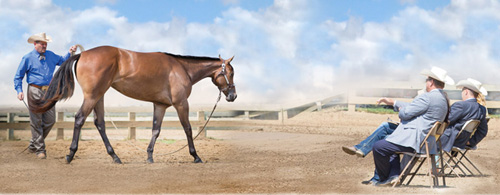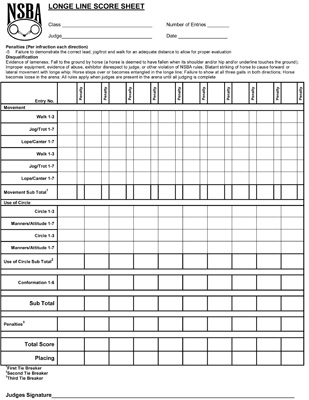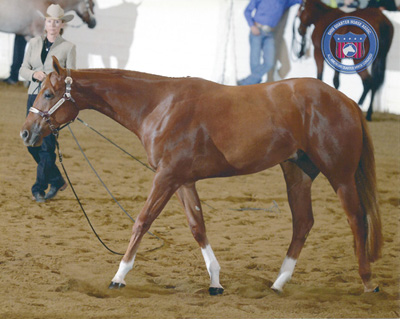 Although through the years, there have been several different Longe Line score sheets approved by the National Snaffle Bit Association, understanding the current scoring system and how your longe liner is evaluated by the judges is a crucial element for success in the show arena.
Although through the years, there have been several different Longe Line score sheets approved by the National Snaffle Bit Association, understanding the current scoring system and how your longe liner is evaluated by the judges is a crucial element for success in the show arena.
In the third section of our in-depth four part series on Longe Line, long-time judges and exhibitors explain how they mark scores, what they see exhibitors commonly do wrong and how to optimize your score.
A member of the National Snaffle Bit Association Longe Line Committee when the current score sheet was created, Bruce Walquist of Cleburne, Texas has shown many NSBA and Palomino Association World Champions as well as futurity champions in Longe Line competition. A professional horse trainer for over 30 years, Walquist has also trained numerous World and Congress Champions in Halter and all-around events. He currently holds judges cards from the American Quarter Horse Association, NSBA and the World Conformation Horse Association.
“In making the current score sheet about three years ago, the NSBA wanted to come up with a score sheet that matched the same verbiage as was being used to define the pleasure horse,” Walquist says. “We all sat down and judged a bunch of classes and put a lot of thought into coming up with the best system.”
As Walquist explains, the current score sheet was intended to give exhibitors a clearer understanding of their score by “making the numbers tighter.” For example, the walk is evaluated on a score from one to three because there is little to judge at this gait. The jog/trot and lope/canter gaits are evaluated on a score from one to seven with four being average, three and under below average and five to seven being above average.
“I was a little skeptical when we first put this system to use but it’s done a really good job and I see the right horses winning,” Walquist says.
According to Walquist, this system has scores for each direction to reflect how the horse travels each way. Since some horses can go a lot better one way over another, the added scores give exhibitors a lot clearer understanding of how they were evaluated.
 In addition, the conformation scoring was changed from the last system evaluating horses on a scale of one to 20 to a scale of one to six.
In addition, the conformation scoring was changed from the last system evaluating horses on a scale of one to 20 to a scale of one to six.
“We changed the conformation scoring to a lot smaller number,” Walquist says. “I think before there was too much room and the numbers were too big to where they didn’t mean anything to the exhibitor. If you say one judge gave you an 11 and another gave you a 17 before, it was pretty unclear as to what the judges thought of the horse’s conformation. With the smaller numbers, it gives you a more uniform score among the judges.”
When evaluating conformation, Walquist likes to see a pretty, well-balanced horse that is correct in the legs and short in the pastern. He looks for a little slope to the shoulder not straight in the shoulder as well as the length of the back, strength of the loin and hock set.
When judging manners and attitude, Walquist likes to see a yearling have expression, be slow and quiet, but not be too robotic or lethargic looking. He rewards exhibitors in their circle score who stand still when longing and let their yearlings out further on the line which demonstrates a higher degree of difficulty. To him, yearlings should respond fairly quickly to the cues and show responsiveness. Excessive whip cracking or having to chase your yearling shows him as the judge that your horse is too tired or not broke enough.
Also, Walquist explains the current Longe Line score sheet also highlights how the judges use tie-breakers with the first tie-breaker being the movement subtotal, the second tie-breaker being the use of circle subtotal and the third tie-breaker being penalties.
“You have to get the right lead when showing but if a yearling picks up a wrong lead the first time but quickly corrects it that’s not the end of the world for me,” Walquist says. “If two horses are very close in scores at the end, it may count as a tie-breaker.”
AQHA Professional Horseman and AQHA, NSBA and WCHA judge, Russ Smith of Whitesboro, Texas has shown countless NSBA, Appaloosa and Paint World Champions in Longe Line competition as well as Congress and major futurity champions. As a long-time judge, Smith believes the current Longe Line scoring system is doing a good job. A member of the NSBA Committe that devised the current system, Smith explains that the old system which was based on larger numbers was hard for scribes and judges to keep track of when judging.
“The biggest thing is the scoring system seems to work,” Smith says. “You need to make a decision pretty fast and sometimes I am surprised when I total up the points which horse is the winner. As a judge, I rely on the score system to determine my placing. I like to see a good cadence and rhythm at the jog and a really good, true loper who has a deep hock, lift in the front and a level top line.”
Overall, Smith likes to see a horse demonstrate all three gears in a timely fashion. He advises exhibitors not to panic about the time. For Smith, use of your circle and manners are very important besides the horse being a good mover.
“I look at the total picture and like to see a horse that is relaxed completing their circles,” Smith says. “A horse that pins its ears, won’t come back to cues, has bad movement or is just unruly will decrease points.”
A professional horse trainer for over 45 years, Shorty Parks of Emmis, Texas has had many Longe Line champions at the NSBA World Show and all the major NSBA futurities. Parks was a member of the NSBA Longe Line Committee that helped to establish the current score sheet.
“The score sheet is a good tool,” Parks says. “It is really legit because you have to mark the gaits to establish your winner instead of watching them all go and then coming up with placings. I think the smaller numbers on the current sheet helped simplify the placings for the public.”
Parks explains that he really likes to see a fit, healthy, shiny show horse who has good disposition and movement. Commonly he has seen exhibitors bring horses to show in the class who are just not ready. Whether its a yearling for Longe Line or a young 2 or 3-year-old futurity horse, Parks believes taking extra time to prepare is key.
“The best mover should win the class as long as they don’t mess up too much,” Parks says. “The whole idea originally was to look at these horses like you were buying a yearling prospect to later ride. When you are showing though, you need to have your horses broke and prepared to show.”
Parks likes to see a good walk and trot but looks for a really nice lope where the prospect is slow legged, flat in their knee and deep in their hock. He also likes a pretty horse that shows a nice mannerly disposition.
“The horse should show good manners at the walk, trot and lope and be able to set up for conformation like a Halter horse,” Parks says. “They need to be broke.”
Long-time succssful Longe Line exhibitor, Kathie Kennedy of Reddick, Florida thinks the judging of the class has really improved over the last few years especially at the bigger shows and futurities. Sometimes at some of the smaller shows, she feels like it is still a discipline class.
“I like the present score sheet. I have to say that, as I am on the Committee for NSBA as a competitor and a promoter of the class, we are striving to have a balanced, good mover with a great presence in the ring both directions even,” Kennedy says. “I think that more emphasis should be put on movement and it does accomplish that.”
For Kennedy, missing a lead depends on the situation and the amount of strides that went wrong in accordance with the score reflection. She thinks it’s really the judge’s call on the extent the score should be affected but it should not affect the horse’s movement score.
“If your horse bucks or plays on the line, it will hurt you in the presentation but should not affect your movement score until it is done in excess,” Kennedy says. “Circle presentation is an area where you can make up some points or lose them very fast. Presentation is so important. Advice to someone showing a longe liner… come join us. It’s a great way to celebrate your breeding program.”

Robin Gollehon: Robin Gollehon has been very successful showing Longe Line classes at NSBA events.
Robin Gollehon of Versailles, Kentucky has successfully shown numerous Longe Line champions at the all the major NSBA events. Breaking down the class, Gollehon explains how she would like to see yearlings properly demonstrated.
“You have a minute and a half to demonstrate the walk, jog and lope both directions,” Gollehon says. “I like to show the class in order of how it’s listed on the NSBA judge’s score sheet. In other words, I don’t lope off before I jog. I advise people not to try to keep time in their head but instead to keep track of the distance traveled. On average, I walk a quarter circle, jog just under a full circle and lope a little more than a circle. I like to be reversing as the announcer says half but sometimes adjustments have to be made.”
Gollehon believes judges are turned off the most by a bad mover who is unruly or unfit. She advises to make your horse very in tune so that “less is more.” In addition, she very much approves of the new scoring system.
“The old score sheet placed too much emphasis on conformation,” Gollehon says. “I had two customers showing in the same class and the horses were pretty comparable. One scored eight points higher in conformation but lower in all categories of movement and still beat the other horse. The score sheet is better since it’s been restructured but the value given for manners/attitude gives the judges a lot of freedom to manage their placings.”
To garner extra points, Gollehon tries to show her horses at the end of the line to gain extra points in the use of the circle.
“The most common mistake I see exhibitors make when showing the class is letting their nerves get the best of them. Their cues become bigger and they don’t manage the clock well,” Gollehon says. ” One other thing I’m very critical of is the way a handler reverses their horse. I teach my horses to stop straight and then if I take a step to the left they know to pivot around and reverse. I don’t like the method of pulling on their head to get them to reverse as that pulls them to the front end and makes them look less broke.”
She thinks judges most appreciate a good mover that’s presented nicely.
“The best advice I could give to someone considering showing a longe liner is to get help from a qualified person and use common sense,” Gollehon says. ” Watch Longe Line classes in person and online and be very self aware. Don’t repeatedly practice the minute and a half routine so your horse thinks ahead.”
Showing in Longe Line competition successfully for many years, Lynn Campbell of Pittsboro, Indiana believes good movement in both the jog and lope should be evaluated by the judges and has seen a shift to both gaits being important with the current scoring system. With the judges having an opportunity to score the yearling both directions, she does not believe that starting to the left all the time is completely necessary.
“Usually I start to the left because that is how we normally set up,” Campbell says. ” But again, given a situation or your colt’s attitude changing it up may be to your benefit.”
Campbell approves of the current scoring system and thinks judges are doing a better job of evaluating the class on account of it.
“I think the parameters and guidelines that NSBA has established are right for the times,” Campbell says. ” If the judges can continue to educate themselves about not only how good the horse moves and carries itself but to realize the time and preparation it takes to present one, they may be more forgiving and realize no matter how well prepared these are still babies and learning their job. More often than not, they will find the best mover in the class.”



You must be logged in to post a comment Login